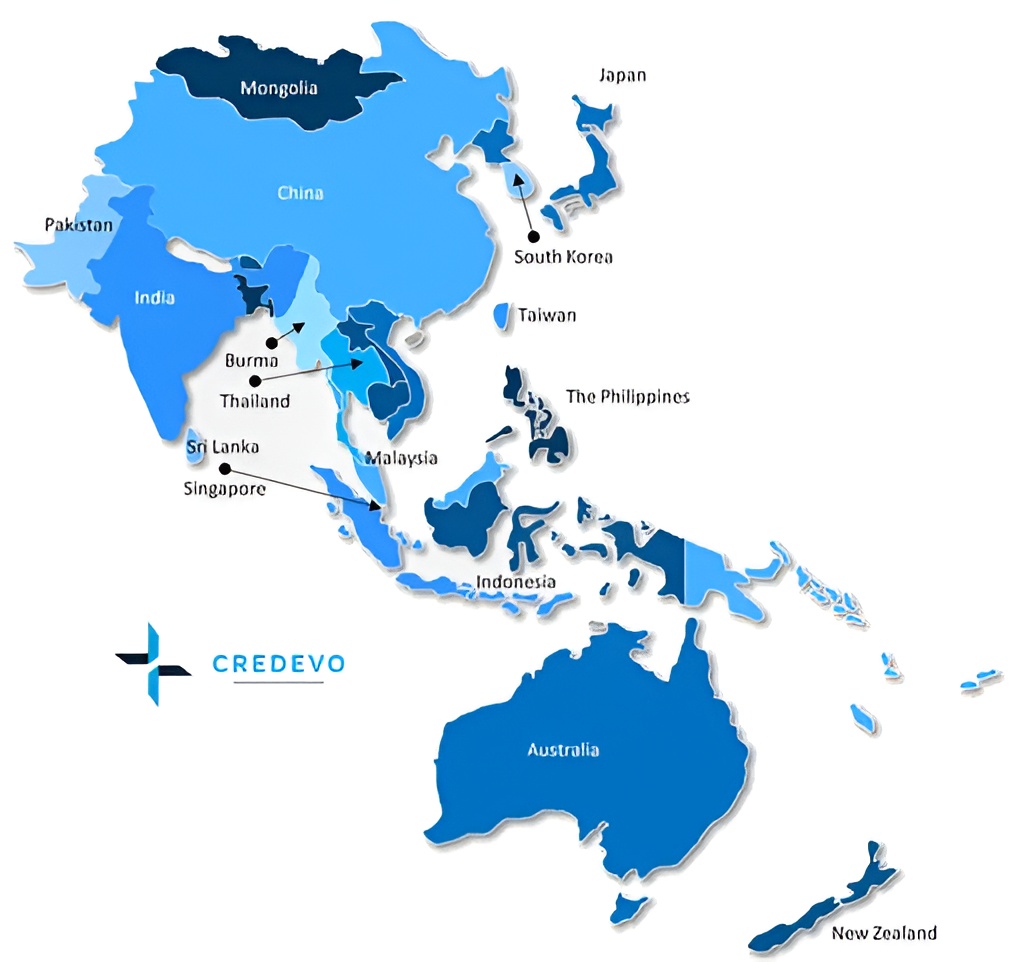Exploring Asia Pacific for Business Expansion: Advantages & Insights

In the fast-changing global business landscape of today, companies are increasingly seeking expansion into the promising Asia Pacific markets. As organizations target this dynamic region, it becomes essential to recognize and navigate the distinct challenges that can emerge along the way.

In this article, we delve into the multifaceted landscape of business expansion in the Asia Pacific and shed light on effective strategies for overcoming some of its key challenges.
Economic Growth and Opportunities in Asia-Pac
The Asia Pacific region stands as one of the most dynamic and rapidly growing economic hubs in the world. With a combined population of over 4.5 billion people and a diverse range of economies, this region presents unparalleled opportunities for businesses looking to expand their operations.
Here’s an elaboration on the economic growth and opportunities that the Asia-Pacific region offers
1. Rapidly Expanding Markets:
- The Asia Pacific is home to some of the world’s fastest-growing economies, such as China, India, Thailand, Indonesia, and Vietnam.
- These countries, along with others in the region, are experiencing significant increases in middle-class populations and rising disposable incomes.
- This demographic shift drives higher consumer spending and creates vast new markets for products and services across various sectors.
2. Booming Sectors and Industries
- Asia Pacific boasts thriving sectors and industries, from technology to renewable energy and healthcare.
- The region’s emerging middle class, combined with increased urbanization and digital adoption, has fueled the demand for innovative solutions and products.
- Businesses looking to expand can tap into these growing industries and position themselves for long-term success.
3. Promising Investment and Trade Opportunities
- Governments in the Asia Pacific have been actively encouraging foreign investment and trade partnerships.
- Special economic zones, tax incentives, and favorable regulations are some of the measures put in place to attract businesses to the region.
- Additionally, various regional trade agreements, like the Comprehensive and Progressive Agreement for Trans-Pacific Partnership (CPTPP), offer access to a vast network of markets with reduced trade barriers.
4. Innovation and Digitalization
- The Asia Pacific region is at the forefront of technological advancements and digital innovation.
- Countries like South Korea, Singapore, and Japan are known for their highly developed tech ecosystems.
- Expanding businesses can leverage the region’s innovative environment to drive digital transformation and adopt cutting-edge technologies that streamline operations and enhance customer experiences.
5. Cross-Border Collaboration
- With proximity and interconnected economies, the Asia Pacific fosters cross-border collaboration and partnerships.
- Businesses that expand into the region can leverage strategic alliances with local companies, distributors, and suppliers to navigate diverse markets and cultural nuances effectively.
6. Diversity of Consumer Preferences
- One of the region’s key challenges and opportunities lies in its diverse consumer preferences. Each country has unique cultural nuances, buying behaviors, and market demands.
- Companies that understand and tailor their products and marketing strategies to cater to local preferences can gain a competitive advantage and foster stronger customer loyalty.
7. Green and Sustainable Initiatives
- Asia Pacific is witnessing a growing focus on sustainability and environmental consciousness. As consumers become increasingly environmentally aware, businesses that incorporate green practices and sustainable solutions can position themselves favorably in the market and appeal to socially responsible consumers.
- Expanding businesses need to assess the economic landscape and identify specific opportunities that align with their offerings and long-term goals.
- With careful planning and an understanding of the region’s economic growth drivers, businesses can capitalize on the vast potential the Asia Pacific holds for success and growth.
Are you interested in exploring business expansion opportunities in the Asia-Pacific region? Click here or Provide your requirements in the form below, and we will be pleased to connect with you to discuss the possibilities.
Vibrant Consumer Base
The Asia Pacific region boasts a vibrant and diverse consumer base, comprising billions of individuals with varying cultures, traditions, and preferences.
To succeed in this dynamic market, businesses must comprehend the intricacies of consumer behavior, customize their products and services to suit local tastes, and navigate cultural sensitivities. Here’s an elaboration on each aspect:
1. Understanding Diverse Consumer Behavior
- The Asia Pacific is a vast and diverse region, encompassing countries with vastly different demographics, social structures, and historical backgrounds. Consumer behavior can vary significantly from one country to another, and even within regions of the same country. Understanding these variations is crucial for businesses looking to expand.
- Market research and consumer insights hold a crucial role in comprehending purchasing decision influencers. These factors encompass price sensitivity, brand loyalty, and preferences for specific attributes. Analyzing data and interacting with local consumers empowers businesses to acquire valuable insights into buying behavior drivers. This information guides strategy customization for better alignment.
2. Tailoring Products and Services to Local Preferences
- A one-size-fits-all approach does not work in the diverse Asia Pacific region. To capture the attention and loyalty of local consumers, businesses must customize their products and services to align with specific market demands. This may involve product localization, packaging adaptations, and incorporating cultural elements into marketing materials.
- Innovative companies can also develop region-specific product variations or launch limited-edition offerings to cater to local festivals or events. By doing so, businesses demonstrate a commitment to understanding and embracing local cultures, fostering a deeper connection with the consumer base.
3. Navigating Cultural Sensitivities for Market Success
- Cultural awareness is essential when expanding into new markets in the Asia Pacific. Each country has its unique customs, traditions, and social norms, and inadvertently offending cultural sensitivities can have adverse effects on a brand’s reputation.
- Companies must invest time and effort in researching and respecting cultural nuances to ensure their marketing messages and brand communications are culturally appropriate. Working with local experts or consultants can offer valuable insights into cultural norms and etiquette, enabling businesses to tailor their approach accordingly.
- Cultural sensitivity also extends to product positioning and branding. Businesses should be cautious not to use symbols or colors that carry negative connotations in certain cultures, and instead, strive for inclusivity and positive representations that resonate with the local audience.
Strategic Geopolitical Location
The Asia Pacific region’s strategic geopolitical location positions it as a pivotal hub for businesses seeking expansion and global market access. With a multitude of countries interconnected by land and sea, the region offers unique advantages for companies looking to expand their reach beyond national borders.

Here’s an elaboration on each aspect of the strategic geopolitical location
1. Asia Pacific as a Gateway to Global Markets
- The Asia Pacific region serves as a gateway between the East and the West, providing businesses with access to some of the world’s most significant and diverse markets.
- With its proximity to major economies such as China, India, Japan, South Korea, and Australia, companies can establish a strong presence in the region to leverage the massive consumer base.
- Additionally, the region’s developed infrastructure and well-connected transportation systems facilitate the smooth movement of goods and services across borders, enhancing market reach.
2. Accessing Supply Chains and Distribution Networks
- Many multinational companies have established complex supply chains in the Asia Pacific region due to their extensive manufacturing capabilities and abundant resources.
- By expanding operations within the region, businesses can tap into these existing supply chains and distribution networks, streamlining production processes and reducing costs.
- This access allows for quicker turnaround times and enables companies to respond effectively to changing market demands.
3. Capitalizing on Regional Trade Agreements
- Asia Pacific is home to several regional trade agreements, promoting trade and reducing trade barriers among member countries. Notably, the Comprehensive and Progressive Agreement for Trans-Pacific Partnership (CPTPP) and the ASEAN Free Trade Area (AFTA) are pivotal agreements facilitating cross-border trade and investment.
- Businesses that expand within these regions can capitalize on reduced tariffs, streamlined customs procedures, and access to a broader customer base, fostering increased competitiveness.
- Moreover, being part of regional trade agreements can shield businesses from sudden changes in global trade dynamics, as these agreements offer a certain level of stability and predictability in international commerce.
Pro-Business Environment
The Asia Pacific region is known for fostering a pro-business environment that attracts companies seeking expansion and growth. Governments in the region have implemented various policies and incentives to encourage foreign investment and stimulate economic development. Additionally, streamlined procedures and favorable regulations make it easier for businesses to operate and thrive
Here’s an elaboration on each aspect of the pro-business environment:
1. Favorable Government Policies and Incentives
- Governments across the Asia Pacific region recognize the crucial role that businesses play in driving economic growth and employment. As a result, they have formulated and implemented policies and incentives to attract foreign direct investment (FDI) and support domestic enterprises.
- These policies may include tax breaks, investment subsidies, grants, and low-interest loans, which aim to reduce the cost of doing business and incentivize companies to invest in the region.
- Additionally, some countries offer specific sector-specific incentives to encourage growth in strategic industries such as technology, renewable energy, and manufacturing.
2. Ease of Doing Business in Asia Pacific
- The Asia Pacific region boasts countries that have made significant strides in improving their business environments. Many governments have streamlined bureaucratic processes, reduced red tape, and implemented online platforms for business registration and licensing.
- These measures have simplified the procedures for setting up businesses, obtaining permits, and complying with regulatory requirements.
- Furthermore, the region’s advanced digital infrastructure and widespread internet connectivity facilitate seamless communication and business transactions, enabling companies to operate efficiently and access a large pool of potential customers.
3. Legal and Regulatory Considerations for Expansion
- When expanding into the Asia Pacific, businesses must be mindful of the legal and regulatory frameworks governing their operations.
- Each country in the region may have different laws and regulations concerning taxation, labor, intellectual property, and environmental compliance.
- Navigating these legal and regulatory considerations requires careful planning and expert advice. Engaging local legal counsel and consultants with knowledge of the specific legal requirements in each country can help businesses ensure compliance and avoid potential pitfalls.
- Moreover, staying informed about changes in regulations and government policies is crucial, as the business landscape in the region can evolve rapidly.
- Businesses that proactively address legal and regulatory considerations can mitigate risks and position themselves for sustainable growth.
Challenges In Asia Pacific for Business Expansion & Mitigation Strategies
Addressing Language and Communication Barriers
Language barriers can pose significant obstacles when expanding into the Asia Pacific region, where diverse linguistic landscapes exist. Effective communication is at the heart of successful business dealings, and overcoming language barriers is essential for building relationships, negotiating deals, and fostering mutual understanding.
Mitigation Strategies
- Localization Efforts: Invest in professional translation and localization services to ensure that marketing materials, product information, and communication are accurately tailored to the local language and cultural nuances.
- Cultural Competence: Train employees and executives to understand and appreciate cultural differences, enabling them to communicate respectfully and effectively across diverse markets.
- Bilingual Staff: Employ bilingual staff or interpreters who can bridge language gaps during crucial business interactions.
Dealing with Cultural and Business Etiquette Differences
Cultural norms and business etiquettes vary widely across the Asia Pacific, and respecting these differences is paramount to building trust and credibility in new markets.
A misstep in cultural etiquette can have far-reaching consequences in terms of relationships and business outcomes.
Mitigation Strategies
- Cultural Sensitivity Training: Educate your team about the cultural norms, traditions, and social customs of the target markets to ensure respectful and appropriate conduct.
- Local Partnerships: Forge alliances with local partners who possess a deep understanding of the market’s culture and business practices.
- Adaptation: Customize your business approach to align with local customs, including communication styles, gift-giving protocols, and negotiation tactics.
Overcoming Infrastructure and Logistics Challenges
The Asia Pacific region encompasses a wide spectrum of infrastructure and logistical capabilities. From densely populated urban centers to remote rural areas, the diversity of landscapes can present logistical hurdles when it comes to supply chain management, distribution, and transportation.
Mitigation Strategies
- Robust Supply Chain Planning: Develop flexible and adaptable supply chain strategies that can navigate varying infrastructural challenges, ensuring a seamless flow of goods and services.
- Local Expertise: Collaborate with logistics partners and consultants who possess local expertise and insights, enabling you to efficiently navigate infrastructure and transportation complexities.
- Technology Integration: Leverage cutting-edge technologies such as blockchain, AI, and data analytics to optimize supply chain visibility and manage inventory efficiently.
Conclusion
As businesses explore expansion opportunities in the dynamic Asia Pacific region, it becomes crucial to comprehend and tackle the challenges at hand. This understanding is pivotal for capitalizing on opportunities and achieving sustained growth. Embracing the richness of cultural diversity and nurturing effective communication are fundamental steps.
Alongside this, the development of agile logistics further enhances an organization’s capabilities. By strategically planning and committing to adaptability, businesses can establish a strong presence and flourish within this vibrant marketplace.
Are you seeking opportunities for business expansion or do you have any questions concerning the Asia-Pacific regions?
Feel free to provide your specific requirements in the space below. Our experienced team will quickly get in touch to support your business development efforts in the Asia-Pacific region.